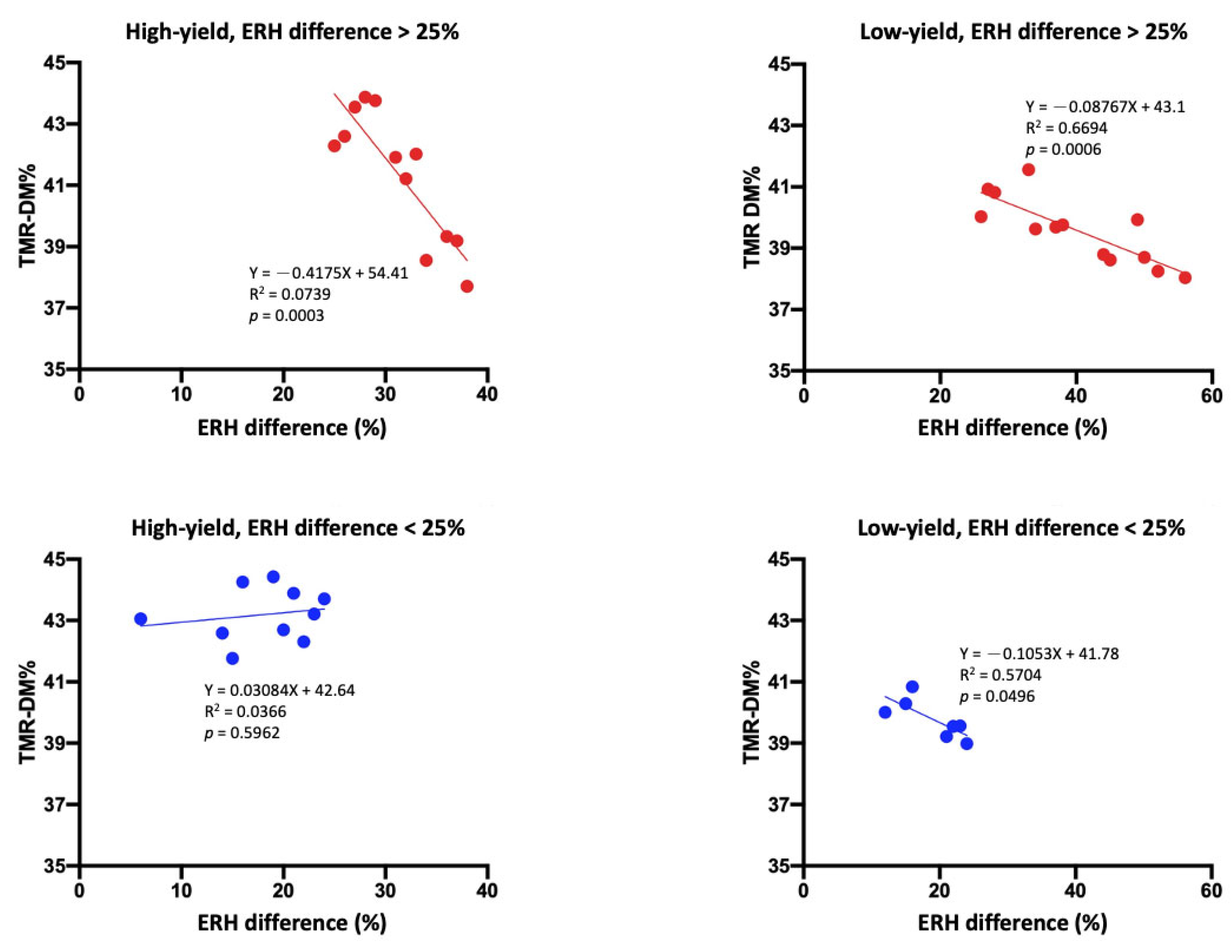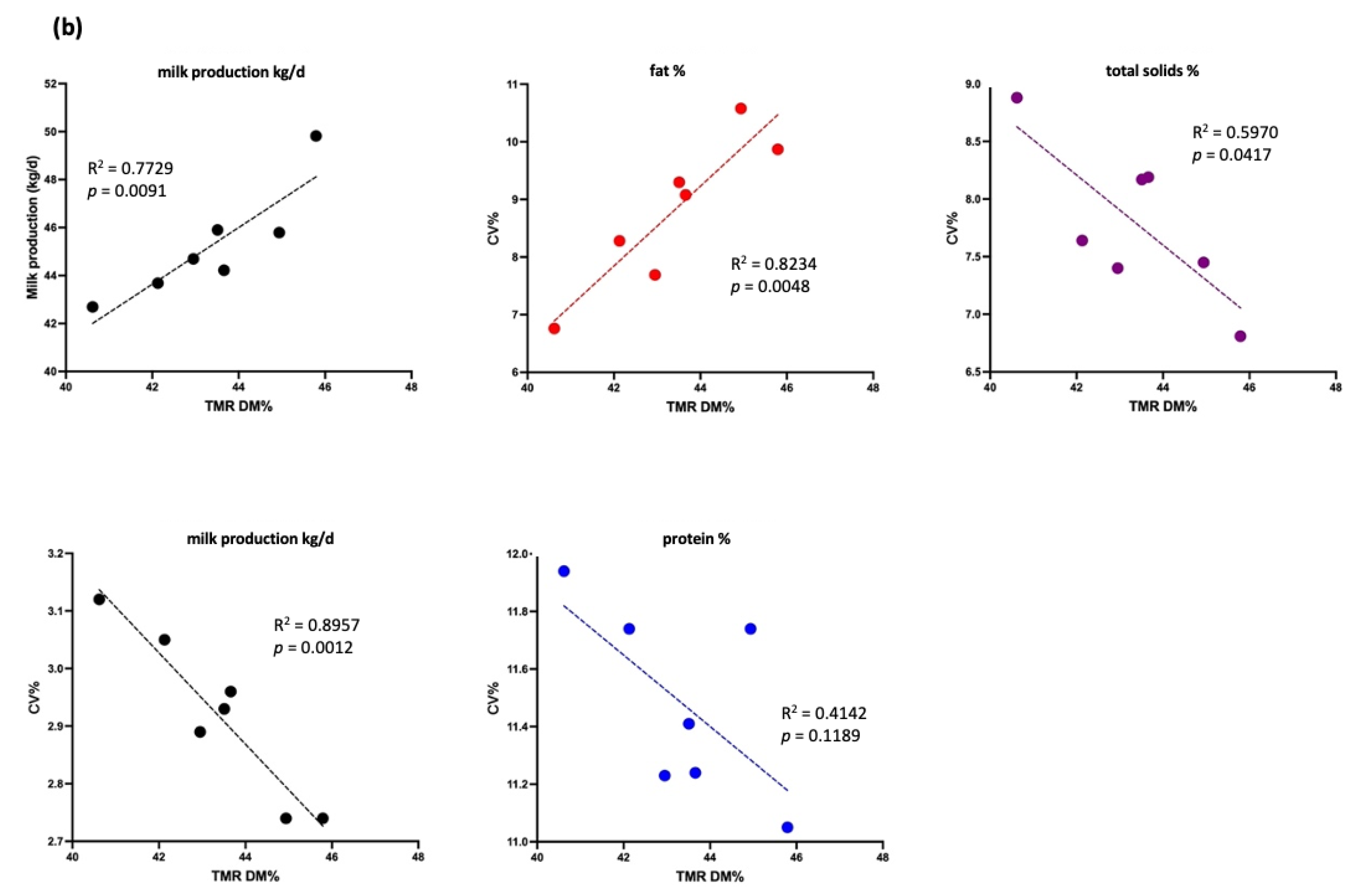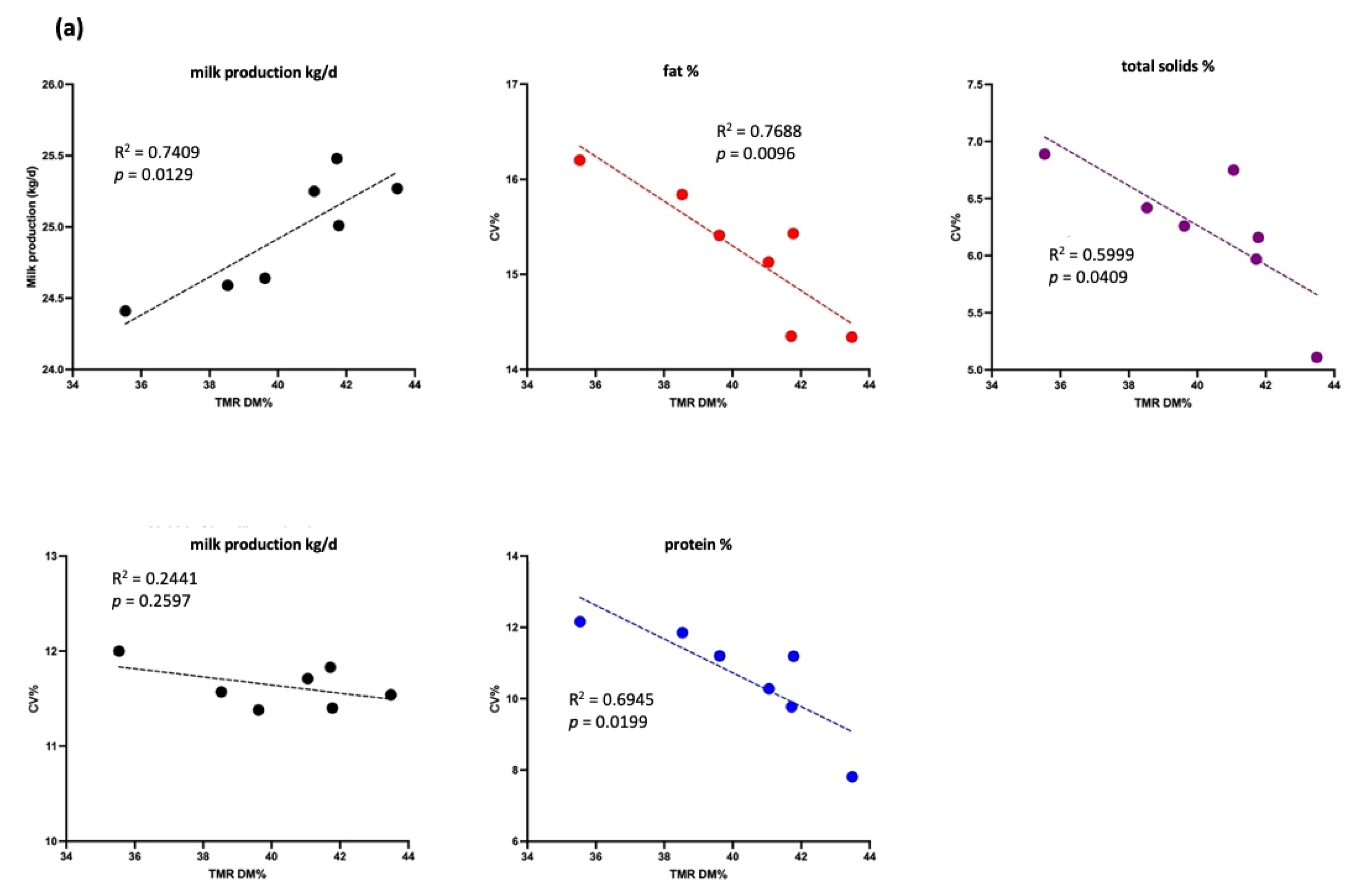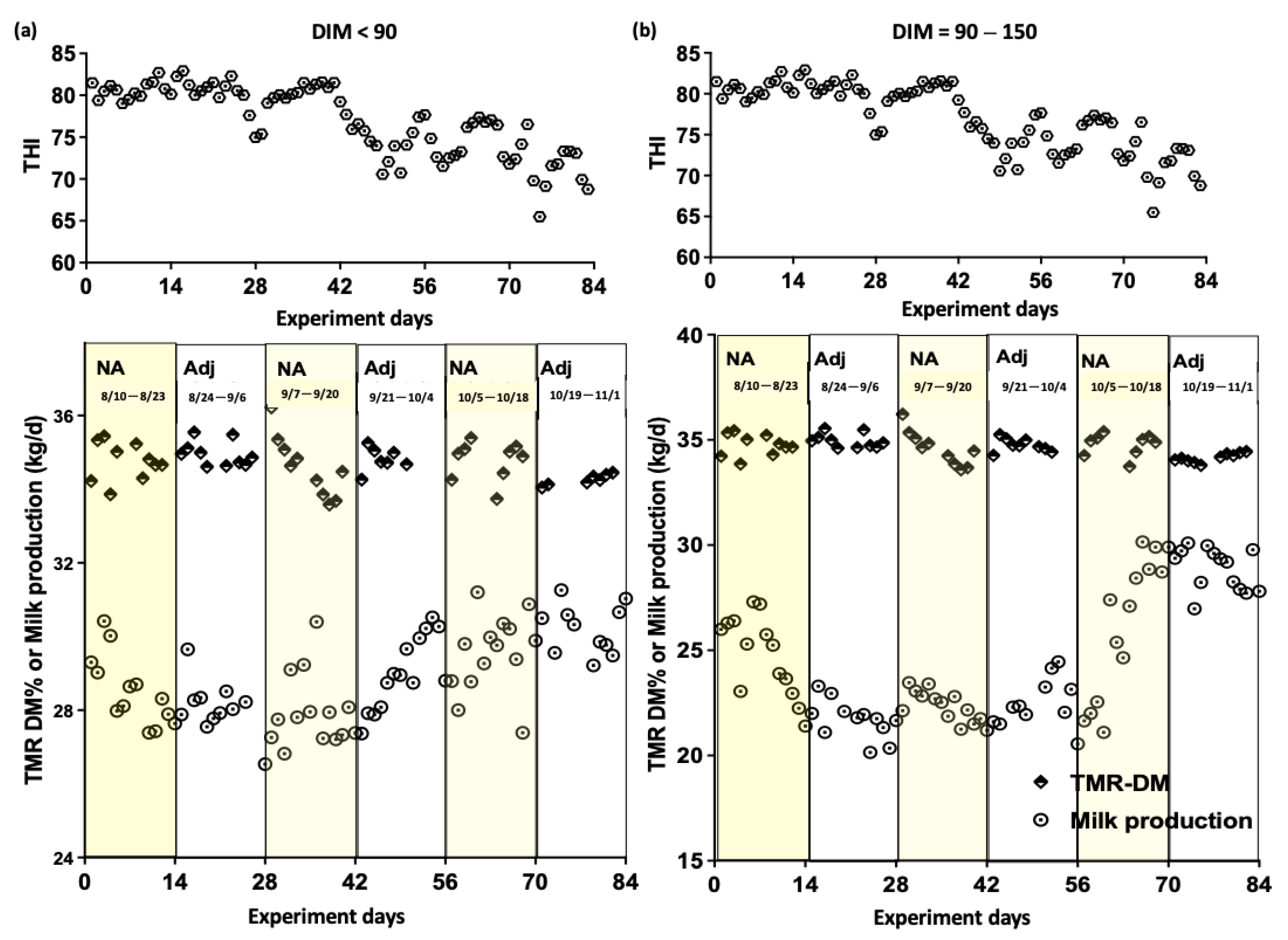Stabilizing Total Mixed Ration Dry Matter to Mitigate Environmental-Relative-Humidity Effects on Lactating Cow Performance
Simple Summary
Abstract
1. Introduction
2. Materials and Methods
2.1. Ethics
2.2. Experiment 1: Effects of ERH on Hay DM
2.3. Experiment 2: Effects of Changes in TMR DM on Production Performance
2.3.1. Animals and Treatments
2.3.2. Effect of Changes in Hay DM on TMR DM and Actual Intake by Cattle
2.3.3. Effect of TMR DM on Production Performance at Different Yield Levels
2.4. Experiment 3: Effects of Precise TMR DM Adjustment on Production Performance at Different THI Values
2.4.1. Animals and Experimental Design
2.4.2. TMR Sampling and Analysis
2.4.3. Milk Production and Composition
2.5. Statistical Analysis
3. Results
3.1. Experiment 1: Effects of ERH on Hay DM
3.2. Experiment 2: Effects of Changes in TMR DM on Production Performance
3.2.1. Effect of Hay DM on Changes in TMR DM and Actual Intake by Cattle
3.2.2. Effect of TMR DM on Production Performance in Cows with Different Yield Levels
3.3. Experiment 3: Effects of a Precise Formulation of TMR DM on Production Performance Under Different THI Values
4. Discussion
4.1. Effects of ERH on Hay DM
4.2. Effects of Variations in TMR DM on Production Performance
4.3. Effects of a Precise Formulation of TMR DM on Production Performance Under Different THI Values
4.4. Practical Implications for Managing TMR DM Under Varying ERH Conditions
5. Conclusions
Author Contributions
Funding
Institutional Review Board Statement
Informed Consent Statement
Data Availability Statement
Acknowledgments
Conflicts of Interest
Abbreviations
| ERH | Environmental relative humidity |
| DM | Dry matter |
| TMR | Total mixture ration |
| DMI | Dry matter intake |
| CV | Coefficient of variation |
| DHI | Dairy herd improvement |
| THI | Temperature–humidity index |
| DIM | Days in milk |
| RH | Relative humidity |
| ECM | Energy-corrected milk |
| CP | Crude protein |
| FPR | Fat-to-protein ratio |
References
- Denißen, J.; Beintmann, S.; Hoppe, S.; Pries, M.; Hummel, J.; Süedekum, K.H. Influence of the addition of water to total mixed rations on the feeding behavior, feed intake and milk performance of high-yielding dairy cows. Livest. Sci. 2021, 254, 104743. [Google Scholar] [CrossRef]
- Joubran, A.M.; Pierce, K.M.; Garvey, N.; Shalloo, L.; O’Callaghan, T.F. Invited review: A 2020 perspective on pasture-based dairy systems and products. J. Dairy Sci. 2021, 104, 7364–7382. [Google Scholar] [CrossRef] [PubMed]
- Sova, A.D.; LeBlanc, S.J.; McBride, B.W.; DeVries, T.J. Accuracy and precision of total mixed rations fed on commercial dairy farms. J. Dairy Sci. 2014, 97, 562–571. [Google Scholar] [CrossRef] [PubMed]
- Weiss, W.P.; Shoemaker, D.; McBeth, L.; Yoder, P.; St-Pierre, N. Within farm variation in nutrient composition of feeds. In Proceedings of the Tri-State Dairy Nutrition Conference, Fort Wayne, IN, USA, 24–25 April 2012; pp. 103–117. [Google Scholar]
- Koakoski, D.L.; Bordin, T.; Cavallini, D.; Buonaiuto, G. A preliminary study of the effects of gaseous ozone on the microbiological and chemical characteristics of whole-plant corn silage. Fermentation 2024, 10, 398. [Google Scholar] [CrossRef]
- Rashid, H.U.; Khan, T.; Turi, A.A.; Abbas, M.; Ullah, K.; Fusaro, I.; Buonaiuto, G.; Cavallini, D. Impact of urea-molasses treated wheat straw levels in total mixed rations on growth and nutrient digestibility in Azikheli buffalo calves. Trop. Anim. Health Prod. 2025, 57, 110. [Google Scholar] [CrossRef]
- IPCC. Climate Change 2014 Synthesis Report; IPCC: Geneva, Switzerland, 2014; pp. 1059–1072. Available online: https://www.ipcc.ch/report/ar5/ (accessed on 1 November 2020).
- Felini, R.; Cavallini, D.; Buonaiuto, G.; Bordin, T. Assessing the impact of thermoregulatory mineral supplementation on thermal comfort in lactating Holstein cows. Vet. Anim. Sci. 2024, 24, 100363. [Google Scholar] [CrossRef]
- Ouellet, V.; Cabrera, V.E.; Fadul-Pacheco, L.; Charbonneau, É. The relationship between the number of consecutive days with heat stress and milk production of Holstein dairy cows raised in a humid continental climate. J. Dairy. Sci. 2019, 102, 8537–8545. [Google Scholar] [CrossRef]
- Vastolo, A.; Serrapica, F.; Cavallini, D.; Fusaro, I.; Atzori, A.S.; Todaro, M. Alternative and novel livestock feed: Reducing environmental impact. Front. Vet. Sci. 2024, 11, 1441905. [Google Scholar] [CrossRef]
- Gasparini, M.; Brambilla, G.; Menotta, S.; Albrici, G.; Avezzù, V.; Vitali, R.; Buonaiuto, G.; Lamanna, M.; Cavallini, D. Sustainable dairy farming and fipronil risk in circular feeds: Insights from an Italian case study. Food Addit. Contam. Part A 2024, 41, 1582–1593. [Google Scholar] [CrossRef]
- Shaver, R.; Kaiser, R. Feeding programs in high producing dairy herds. In Proceedings of the Tri-State Dairy Nutrition Conference, Fort Wayne, IN, USA, 27–28 April 2004; pp. 143–170. [Google Scholar]
- Castillo, A.R.; Di Rienzo, J.A.; Cavallini, D. Effect of a mix of condense and hydrolysable tannins feed additive on lactating dairy cows’ services per conception and days open. Vet. Anim. Sci. 2025, 27, 100434. [Google Scholar] [CrossRef]
- Leonardi, C.; Giannico, F.; Armentano, L.E. Effect of water addition on selective consumption (sorting) of dry diets by dairy cattle. J. Dairy Sci. 2005, 88, 1043–1049. [Google Scholar] [CrossRef] [PubMed]
- Piccioli-Cappelli, F.; Calegari, F.; Calamari, L.; Bani, P.; Minuti, A. Application of a NIR device for precision feeding in dairy farms: Effect on metabolic conditions and milk production. Ital. J. Anim. Sci. 2019, 18, 754–765. [Google Scholar] [CrossRef]
- Lamanna, M.; Bovo, M.; Cavallini, D. Wearable collar technologies for dairy cows: A systematized review of the current applications and future innovations in precision livestock farming. Animals 2025, 15, 458. [Google Scholar] [CrossRef] [PubMed]
- Chen, C.S.; Liu, H.H.; Yu, T.H. Investigation and test on moisture removal effect in modified container hay barn. J. Taiwan Livest. Res. 2022, 55, 221–229. [Google Scholar] [CrossRef]
- NRC. Nutrient Requirements of Dairy Cattle, 7th rev. ed.; National Academy Press: Washington, DC, USA, 2001. [Google Scholar]
- Dikmen, S.E.; Alava, E.; Pontes, E.; Fear, J.M.; Dikmen, B.Y.; Olson, T.A.; Hansen, P.J. Differences in thermoregulatory ability between slick-haired and wild-type lactating Holstein cows in response to acute heat stress. J. Dairy Sci. 2008, 91, 3395–3402. [Google Scholar] [CrossRef]
- Armstrong, D. Heat stress interaction with shade and cooling. J. Dairy Sci. 1994, 77, 2044–2050. [Google Scholar] [CrossRef]
- Oman, S.D.; Seiden, E. Switch-back designs. Biometrika 1988, 75, 81–89. [Google Scholar] [CrossRef]
- AOAC. Official Methods of Analysis of AOAC International, 17th ed.; AOAC International: Rockville, MD, USA, 2000. [Google Scholar]
- Western, M.M.; de Souza, J.; Lock, A.L. Milk production responses to altering the dietary ratio of palmitic and oleic acids varies with production level in dairy cows. J. Dairy Sci. 2020, 103, 11472–11482. [Google Scholar] [CrossRef]
- Bouasker, M.; Belayachi, N.; Hoxha, D.; Al-Mukhtar, M. Physical characterization of natural straw fibers as aggregates for construction materials applications. Materials 2014, 7, 3034–3048. [Google Scholar] [CrossRef]
- Sahu, P.; Gupta, M.K. Water absorption behavior of cellulosic fibres polymer composites: A review on its effects and remedies. J. Ind. Text. 2022, 51 (Suppl. 5), 7480S–7512S. [Google Scholar] [CrossRef]
- Van Soest, P.V.; Robertson, J.B.; Lewis, B.A. Methods for dietary fiber, neutral detergent fiber, and nonstarch polysaccharides in relation to animal nutrition. J. Dairy Sci. 1991, 74, 3583–3597. [Google Scholar] [CrossRef] [PubMed]
- Carrillo-Díaz, M.I.; Miranda-Romero, L.A.; Chávez-Aguilar, G.; Zepeda-Batista, J.L.; González-Reyes, M.; García-Casillas, A.; Tirado-González, D.N.; Tirado-Estrada, G. Improvement of ruminal neutral detergent fiber degradability by obtaining and using exogenous fibrolytic enzymes from white-rot fungi. Animals 2022, 12, 843. [Google Scholar] [CrossRef] [PubMed]
- Ishler, V. The case for taking weekly silage dry matter. Hoards Dairym. 2001, 10, 341. [Google Scholar]
- Čejna, V.; Chládek, G. The importance of monitoring changes in milk fat to milk protein ratio in Holstein cows during lactation. J. Cent. Eur. Agric. 2005, 6, 539–546. [Google Scholar] [CrossRef]
- Buttchereit, N.; Stamer, E.; Junge, W.; Thaller, G. Evaluation of five lactation curve models fitted for fat: Protein ratio of milk and daily energy balance. J. Dairy Sci. 2010, 93, 1702–1712. [Google Scholar] [CrossRef]
- Jenkins, N.T.; Peña, G.; Risco, C.; Barbosa, C.C.; Vieira-Neto, A.; Galvão, K.N. Utility of inline milk fat and protein ratio to diagnose subclinical ketosis and to assign propylene glycol treatment in lactating dairy cows. Can. Vet. J. 2015, 56, 850. [Google Scholar]
- Televičius, M.; Juozaitiene, V.; Malašauskienė, D.; Antanaitis, R.; Rutkauskas, A.; Urbutis, M.; Baumgartner, W. Inline milk lactose concentration as biomarker of the health status and reproductive success in dairy cows. Agriculture 2021, 11, 38. [Google Scholar] [CrossRef]
- Abeni, F.; Bertoni, G. Main causes of poor welfare in intensively reared dairy cows. Ital. J. Anim. Sci. 2009, 8, 45–66. [Google Scholar] [CrossRef]
- Hall, M.B. Invited review: Corrected milk: Reconsideration of common equations and milk energy estimates. J. Dairy Sci. 2023, 106, 2230–2246. [Google Scholar] [CrossRef]
- Uyeh, D.D.; Kim, J.; Lohumi, S.; Park, T.; Cho, B.K.; Woo, S.; Ha, Y. Rapid and non-destructive monitoring of moisture content in livestock feed using a global hyperspectral model. Animals 2021, 11, 1299. [Google Scholar] [CrossRef]
- Baumgard, L.H.; Wheelock, J.B.; Sanders, S.R.; Moore, C.E.; Green, H.B.; Waldron, M.R.; Rhoads, R.P. Postabsorptive carbohydrate adaptations to heat stress and monensin supplementation in lactating Holstein cows. J. Dairy Sci. 2011, 94, 5620–5633. [Google Scholar] [CrossRef]
- Baumgard, L.H.; Rhoads, R.P. Ruminant nutrition symposium: Ruminant production and metabolic responses to heat stress. J. Anim. Sci. 2012, 90, 1855–1865. [Google Scholar] [CrossRef]








| Item | Experiment 2 (% Dry Matter Basis) | Experiment 3 (% Dry Matter Basis) | |
|---|---|---|---|
| High Yield | Low Yield | ||
| Ingredient proportions | |||
| Timothy hay | 7.8 | 14.8 | - |
| Oat hay | 19.6 | 24.6 | - |
| Bermuda grass hay | - | - | 29.9 |
| Alfalfa hay | 20.6 | 14.8 | 20.4 |
| Brewer’s grains, wet | 3.4 | 8.6 | - |
| Soybean hull | 3.9 | 9.9 | 12.8 |
| Wheat bran | - | - | 3.6 |
| Corn | 21.5 | 13.5 | 16.3 |
| Corn gluten meal | 3.1 | 1.9 | 2.3 |
| Soybean meal, 44% CP | 12.9 | 8.1 | 9.8 |
| Fish meal | 1.5 | 1.0 | 1.2 |
| Molasses | 2.2 | 1.4 | 1.7 |
| Iodized salt | 0.3 | 0.2 | 0.3 |
| Sodium bicarbonate | 0.9 | 0.6 | 0.7 |
| Limestone | 0.8 | 0.5 | 0.6 |
| Bypass fat | 1.0 | - | - |
| Methionine | 0.1 | 0.1 | - |
| Premix † | 0.4 | 0.1 | 0.4 |
| Total | 100 | 100 | 100 |
| Nutrient composition | |||
| DM | 45.9 | 43.9 | 35.9 |
| Crude protein | 17.8 | 16.1 | 16.0 |
| Crude fat | 3.3 | 2.8 | 2.3 |
| Neutral detergent fiber | 40.9 | 48.7 | 45.4 |
| Acid detergent fiber | 24.8 | 29.0 | 28.1 |
| Forage Source † | Difference in DM (%) | DM (%) in ERH (%) = 10 (Maximum) | DM (%) in ERH (%) = 90 (Minimum) |
|---|---|---|---|
| Oat hay | 4.88 ± 0.21 | 88.42 ± 0.22 | 83.55 ± 0.01 |
| Timothy hay | 5.65 ± 1.03 | 87.81 ± 0.07 | 82.16 ± 1.10 |
| Mixed-grass hay * | 6.15 ± 1.21 | 88.31 ± 0.59 | 82.15 ± 1.80 |
| Alfalfa hay | 4.60 ± 0.03 | 89.62 ± 0.11 | 85.01 ± 0.14 |
| Source † | Moisture Content (%) | Maximum (%) | Minimum (%) | Difference (%) |
|---|---|---|---|---|
| Alfalfa hay | 12.25 ± 1.51 | 14.29 | 10.02 | 4.29 |
| Grass hay * | 10.78 ± 1.93 | 14.00 | 8.17 | 5.83 |
| Item (kg/cow/d) | High Yield | Low Yield | ||
|---|---|---|---|---|
| Dry matter intake | 22.83 ± 0.32 | 19.31 ± 0.19 | ||
| Maximum | 23.3 | 19.67 | ||
| Minimum | 22.21 | 18.83 | ||
| Difference | 1.09 | 0.84 | ||
| Crude protein intake | 3.41 ± 0.03 | 2.74 ± 0.02 | ||
| Maximum | 3.47 | 2.79 | ||
| Minimum | 3.32 | 2.68 | ||
| Difference | 0.15 | 0.11 | ||
| 38–41% TMR DM | 42–44% TMR DM | 38–39% TMR DM | 40–41% TMR DM | |
| Dry matter intake | 22.15 ± 2.13 | 23.0 ± 1.64 | 17.81 ± 2.80 | 19.10 ± 1.36 |
| Crude protein intake | 3.28 ± 0.31 | 3.43 ± 0.13 | 2.70 ± 0.41 | 2.77 ± 0.19 |
| Item | THI = 65–82 | THI > 72 | THI ≤ 72 | |||||||||
|---|---|---|---|---|---|---|---|---|---|---|---|---|
| NA * | Adj | SEM | p-Value | NA | Adj | SEM | p-Value | NA | Adj | SEM | p-Value | |
| Milk yield (kg/d) | 26.987 | 27.289 | 0.328 | 0.041 | 26.158 | 26.162 | 0.861 | 0.662 | 28.303 | 27.786 | 0.432 | 0.310 |
| Milk fat (%) | 3.716 | 3.654 | 0.095 | 0.131 | 3.602 | 3.657 | 0.271 | 0.871 | 3.887 | 3.653 | 0.077 | <0.001 |
| Milk protein (%) | 3.040 | 2.990 | 0.056 | 0.102 | 3.088 | 2.985 | 0.085 | 0.103 | 2.965 | 2.992 | 0.051 | 0.378 |
| Milk fat-to-protein ratio | 1.222 | 1.222 | 1.166 | 1.225 | 1.311 | 1.221 | ||||||
| Item | NA * | Adj | p-Value |
|---|---|---|---|
| DIM † < 90 | |||
| Milk yield (kg/d) | 1.31 ± 0.34 | 0.77 ± 0.16 | 0.014 |
| Fat (%) | 0.12 ± 0.03 | 0.10 ± 0.02 | 0.261 |
| Protein (%) | 0.13 ± 0.02 | 0.08 ± 0.02 | 0.018 |
| ECM (kg/d) | 0.47 ± 0.06 | 0.20 ± 0.09 | 0.020 |
| DIM 90–150 | |||
| Milk yield (kg/d) | 1.03 ± 0.09 | 0.66 ± 0.14 | 0.034 |
| Fat (%) | 0.17 ± 0.03 | 0.11 ± 0.02 | 0.017 |
| Protein (%) | 0.16 ± 0.02 | 0.12 ± 0.02 | 0.274 |
| ECM (kg/d) | 0.15 ± 0.09 | 0.09 ± 0.01 | 0.014 |
Disclaimer/Publisher’s Note: The statements, opinions and data contained in all publications are solely those of the individual author(s) and contributor(s) and not of MDPI and/or the editor(s). MDPI and/or the editor(s) disclaim responsibility for any injury to people or property resulting from any ideas, methods, instructions or products referred to in the content. |
© 2025 by the authors. Licensee MDPI, Basel, Switzerland. This article is an open access article distributed under the terms and conditions of the Creative Commons Attribution (CC BY) license (https://creativecommons.org/licenses/by/4.0/).
Share and Cite
Chen, Y.-H.; Chen, Y.-M.; Tu, P.-A.; Chen, C.-Y.; Wang, H.-T. Stabilizing Total Mixed Ration Dry Matter to Mitigate Environmental-Relative-Humidity Effects on Lactating Cow Performance. Animals 2025, 15, 1137. https://doi.org/10.3390/ani15081137
Chen Y-H, Chen Y-M, Tu P-A, Chen C-Y, Wang H-T. Stabilizing Total Mixed Ration Dry Matter to Mitigate Environmental-Relative-Humidity Effects on Lactating Cow Performance. Animals. 2025; 15(8):1137. https://doi.org/10.3390/ani15081137
Chicago/Turabian StyleChen, Yi-Hsuan, Yi-Ming Chen, Po-An Tu, Ching-Yi Chen, and Han-Tsung Wang. 2025. "Stabilizing Total Mixed Ration Dry Matter to Mitigate Environmental-Relative-Humidity Effects on Lactating Cow Performance" Animals 15, no. 8: 1137. https://doi.org/10.3390/ani15081137
APA StyleChen, Y.-H., Chen, Y.-M., Tu, P.-A., Chen, C.-Y., & Wang, H.-T. (2025). Stabilizing Total Mixed Ration Dry Matter to Mitigate Environmental-Relative-Humidity Effects on Lactating Cow Performance. Animals, 15(8), 1137. https://doi.org/10.3390/ani15081137







